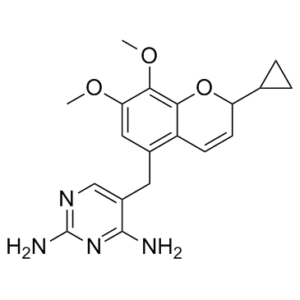This product is for research use only, not for human use. We do not sell to patients.

| Size | Price | Stock |
|---|---|---|
| 100mg | $3050 | Check With Us |
| 200mg | $4575 | Check With Us |
| 500mg | $7720 | Check With Us |
Cat #: V3315 CAS #: 192314-93-5 Purity ≥ 98%
Description: Iclaprim (formerly known as AR-100 and RO-482622) is a novel diaminopyrimidine, and a selective inhibitor of dihydrofolate reductase which can inhibit the growth of S. aureus (MRSA) with an MIC90 of 0.06 μg/mL. It has shown potent, extended-spectrum in vitro activity against Gram-positive bacteria, including methicillin-resistant Staphylococcus aureus, vancomycin-intermediate and vancomycin-resistant S. aureus and macrolide-, quinolone- and trimethoprim-resistant strains. In addition, iclaprim has demonstrated activity against Streptococcus pneumoniae including penicillin-, erythromycin-, levofloxacin- and trimethoprim/sulfamethoxazole-resistant strains. Furthermore, in vitro activity has also been observed against Gram-negative bacteria and atypical bacteria. The pharmaco-kinetic profile of this agent reveals that iclaprim is available for intravenous and oral use, with good oral bioavailability. Phase II clinical trials have shown promise in its use for complicated skin and skin structure infections that are caused by methicillin-resistant S. aureus and two Phase III clinical trials have been recently completed for the same indication. Phase II trials evaluating the efficacy in respiratory infections are expected to start in 2007. At this early point in clinical development, the available reported data indicate potential for iclaprim as a new antibiotic for parenteral and oral treatment of complicated skin and skin structure infections.
Publications Citing InvivoChem Products
Product Promise

- Physicochemical and Storage Information
- Protocol
- Related Biological Data
- Stock Solution Preparation
- Quality Control Documentation
| Molecular Weight (MW) | 354.41 |
|---|---|
| Molecular Formula | C19H22N4O3 |
| CAS No. | 192314-93-5 |
| Storage | -20℃ for 3 years in powder formr |
| -80℃ for 2 years in solvent | |
| Solubility In Vitro | DMSO: ≥ 30mg/mLr |
| Water: N/Ar | |
| Ethanol: N/A | |
| SMILES Code | NC1=NC=C(CC2=CC(OC)=C(OC)C3=C2C=CC(C4CC4)O3)C(N)=N1 |
| Synonyms | RO-482622; RO 482622; RO482622; AR-100; AR100; AR 100; RO-48-2622; AR-100.001 |
| Protocol | In Vitro | Iclaprim inhibits the growth of S. aureus (MRSA) with an MIC90 of 0.06 μg/mL |
|---|
| Solvent volume to be added | Mass (the weight of a compound) | |||
|---|---|---|---|---|
| Mother liquor concentration | 1mg | 5mg | 10mg | 20mg |
| 1mM | 2.8216 mL | 14.1080 mL | 28.2159 mL | 56.4318 mL |
| 5mM | 0.5643 mL | 2.8216 mL | 5.6432 mL | 11.2864 mL |
| 10mM | 0.2822 mL | 1.4108 mL | 2.8216 mL | 5.6432 mL |
| 20mM | 0.1411 mL | 0.7054 mL | 1.4108 mL | 2.8216 mL |
This equation is commonly abbreviated as: C1 V1 = C2 V2
- (1) Please be sure that the solution is clear before the addition of next solvent. Dissolution methods like vortex, ultrasound or warming and heat may be used to aid dissolving.
- (2) Be sure to add the solvent(s) in order.




































